|
Historic Memphis
Bridges |
|
...
across the Mississippi |
|
|
|
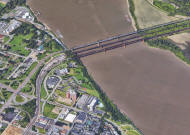 |
From the earliest days of the
steamboat,
Memphis has been a major center of river
transportation. Passenger steamers linked Memphis with river ports
up and down the Mississippi, Ohio, and Missouri Rivers. If
trains hadn't become a major factor in commerce and transportation,
it's doubtful that Memphis would have given a bridge across the
Mississippi a serious thought. The city's first bridge was
built in 1892, as a railroad bridge. Carriage or Automobile
traffic was not a serious factor. And when the second bridge
was built in 1916, roadways still seemed to be almost a second
thought, because they were hung off both sides in 1917. This
is the story of those early bridges and others that have been added
since. |
|
|
|
|
|
|
|
Click on
small photos to see larger photos. |
|
|
|
|
The Frisco Bridge
...The
Great Bridge at Memphis ...The Memphis Bridge ...The
Iron Bridge |
|
|
|
It
must be a law that any type of architectural structure in
Memphis should have more than one name. The Frisco
Bridge is no exception. It's
original name was
The
Great Bridge at Memphis,
.
Later that was shortened to
The
Memphis Bridge
and commonly referred to as
The Iron Bridge.
The name was changed again to
The
Frisco Bridge
when the Harahan Bridge was built in 1916. But no matter
what name you call it, it is considered one of America's
great bridges. |
 |
|
|
|
|
The
Frisco Bridge was the first bridge built on the lower
Mississippi, and the only bridge south of St. Louis when it
opened in 1892. Building it was a monumental undertaking.
The US Army insisted on a 770 foot clear span for river
navigation, and at least 75 feet of vertical clearance under
the bridge. The result was that the Frisco Bridge had the
longest span of any bridge in the US at this time. In order to secure
a building permit, city officials insisted that the bridge
somehow would carry pedestrian and buggy traffic as well as trains.
Thus the deck was built somewhat wider than would have been
required for a single railroad track. As a result, two
way buggy traffic was periodically allowed. If a train needed to
cross the bridge, wagon and buggy traffic was stopped and
cleared from the bridge, and then the train was allowed to
cross.
|
|
|
|
|
 |
 |
 |
 |
|
The Frisco Bridge |
The Frisco Bridge - 1891 |
Frisco -Construction 1891 |
Frisco - Construction 1891 |
|
|
|
|
 |
|
Architectural Elevation Drawing |
|
|
|
The
Frisco Bridge is 1895 feet long, was built of steel and cost $3,000,000.
It was built by master bridge builder George S. Morison and the Kansas
City-Memphis Railway-Bridge Company. On some early
postcards you will see a 5th name for this bridge -
The
Kansas City and Memphis Railway Bridge. |
|
|
 |
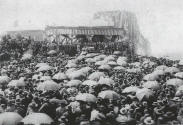 |
 |
 |
|
Plan Drawing 1891 |
The Frisco - Dedication |
The Frisco |
The Frisco Postcard |
|
|
|
|
The United
States allowed its bridge inventory to go without inspections during
much of the twentieth century. Many bridges deteriorated to a
dangerous level before problems were discovered. The Frisco
Bridge deteriorated to the point that a 10 mile per hour speed limit
was posted. Repairs have now been made and the traffic
restrictions have eased.
The Frisco Bridge is listed
among the Top 10 Bridges worldwide in the Nov. 2010 issue of Train
magazine "70 Great Railroad Engineering Feats: Bridges & Viaducts" |
|
|
|
|
|
|
|
|
|
|
|
|
|
|
|
The Harahan Bridge
...
Rock Island Bridge
...
The Missouri Pacific Iron Mountain
Bridge
|
|
|
|
This is
the only railroad bridge between St. Louis and the Gulf of Mexico
that is also used simultaneously by pedestrians and vehicles. It was originally
named
The Rock
Island Bridge
and was
renamed after James T. Harahan, the president of Rock Island Railroad was killed four
years before the bridge was completed. Ironically he was
killed when his car was hit by an oncoming train. On
postcards this bridge is sometimes called
The
Missouri Pacific Iron Mountain Bridge.
Completed
in 1916 the bridge was structurally advanced for its time,
although 23 workers of the steel company lost their lives
during its construction. In 1917 cars and trucks were
allowed to use the bridge, single file, driving on a narrow,
one way wooden "roadway" that was suspended on the OUTSIDE of
the bridge. There was only a short railing on the
outside edge of the road.
|
 |
|
James T. Harahan
|
|
|
|
|
It wasn't
until 1949 when the Memphis-Arkansas Bridge opened, that drivers had
a much safer means of crossing to Arkansas. Freight trains
continue to use the Harahan Bridge. The main bridge structure is
2,548 feet long. The bridge spans match the lengths of the
bridge spans of the older Frisco Bridge. This was required by
the US Army Corps of Engineers to ensure that the piers would line
up so as not to encroach on the navigation channels.
|
|
|
|
|
|
|
|
|
|
|
 |
|
Dedication Plaque |
|
In 1928
the eastbound highway lane, which consisted of wooden planks over a
steel frame, caught fire near pier #1 (near the Memphis side).
The eastbound lane was totally consumed in the fire along the entire
length of the 790 foot span. The westbound lanes were burned
an additional 180 feet to the west of pier #2, destroying the
roadway on part of the 621 foot long span. The bridge was
closed for over a year. A total of 950 tons of new
structural steel was installed and a more fire resistant roadway was
installed. Afterwards traffic on the Harahan continued to
increase substantially. By the time the Memphis-Arkansas
automobile bridge was built in 1949, the daily volume of
automobiles using the Harahan 's two lanes had increased to
11,000. Stalled vehicles and slow farm tractors
frequently caused substantial delays. |
|
|
|
|
When the
Memphis-Arkansas bridge finally opened, some farm vehicles
continued to use the Harahan until 1954 when all the old
"suspended" highway lanes on either side were removed. Some of
the concrete for these old lanes still exists, along with the ramps
that carried the traffic up to the bridge. A short section of
pavement for the westbound lane still exists on the east end of the
bridge. |
 |
| |
|
 |
The
Harahan now sports a new roadway ... a pedestrian and bicycle crossing.
Opened in 2016 it's now called "Big River Crossing"
and is
the longest pedestrian-bike bridge across the Mississippi. The
views of the city and the surrounding areas are beautiful. At
night the bridge is illuminated with "The Mighty Light" show - a
magnificent LED display of the Harahan Bridge (and the Hernando DeSoto Bridge. Every night - on the hour, from sunset to 10
PM. (Photos will be added - when available) |
|
Big River
Crossing |
|
|
|
|
|
|
|
|
|
|
|
|
|
|
|
The Memphis
and
Arkansas Bridge
...
Memphis-Arkansas Memorial Bridge
...
Old Bridge |
|
|
 |
This
bridge has 5 names:
Memphis
and Arkansas Bridge,
Memphis-Arkansas Bridge,
Memphis-Arkansas Memorial Bridge,
Memphis & Arkansas Memorial Bridge,
and now a new name, The
Old Bridge.
The Memphis-Arkansas Bridge was built in 1949 as part of the
US-40. It replaced the narrow traffic lanes that were
attached to each side of the Harahan Bridge. It was
built before the introduction of the Interstate Highway
System, so the span was not built to Interstate standards.
It lacked the concrete barrier between the different
directions of traffic and they were added later. It was
also built with a sidewalk on either side of the roadway.
They are also now separated from the traffic lanes by concrete
barriers. However sidewalk travel has been prohibited on
the bridge. |
|
Memphis-Arkansas Bridge |
|
|
|
|
|
This
bridge cost $10.5 million and as part of Interstate 55, it connects
Arkansas with Tennessee. Unfortunately it was not built
to withstand an earthquake and can't be retrofitted with seismic
protection. When this bridge opened it meant there were now
three bridges at this location - approximately 150 feet apart.
The upstream structure is the Harahan Bridge. The Frisco
Bridge is the middle structure, and the Memphis-Arkansas Bridge is
next in line. As of 2007
the Memphis-Arkansas Bridge continues to serve as a vital automobile
conduit for cross-river traffic. It carries 50,000 cars each
day - only about 5,000 fewer than the newer Hernando de Soto Bridge
to the north. |
 |
|
|
|
|
|
 |
<
The
Commercial Appeal published a 28 page souvenir edition
in 1949 to celebrate the opening of the new Memphis
and Arkansas Bridge. This very rare edition is posted in its
entirety below. Great articles and vintage advertising.
The files have been made very large so that they will be easy to read.
Please be patient while the pages load.
...
Collection of Dave French.
|
|
|
|
|
|
|
|
|
|
|
|
|
|
|
|
|
|
|
|
|
|
|
|
|
Hernando De Soto Bridge
...
The "M" Bridge ...
The New Bridge |
|
|
 |
The
Hernando De Soto Bridge opened in 1973 and carries more than
55,000 vehicles each day. It is referred to
as the
"M"
Bridge
because the arches resemble the letter M. Many Memphians
call it the "New
Bridge"
simply because it's newer than the Memphis-Arkansas Bridge.
And it's also referred to, with a slight wink, as "The Dolly
Parton Bridge." The bridge is named for 16th
century Spanish explorer Hernando de Soto who explored this
stretch of the Mississippi River, and died south of Memphis.
Because the I-40 crossing over the Mississippi is a vital
structure for the traffic and freight in America, it was
determined in the 1990's that the Hernando De Soto Bridge
should be retrofitted to withstand an earthquake.
Several phases of the project have been completed. This
project is federally funded at 80% and the total cost will be
in excess of $175 million. |
|
Hernando De Soto Bridge |
|
|
|
|
|
At night,
the bridge is illuminated by 200 sodium vapor lights along its "M"
structure. The big "M" on the bridge has become a symbol of
the city. It was first lit in 1986 after $373,000 in
private funds had been raised to fund the cost and installation of
the lights. Pilots complained that the lights made navigation
through the piers difficult because the lights reflected on the
water. The city installed a remote switch to toggle the lights
on and off briefly while a vessel passes under the bridge. |
 |
|
|
|
|
|
|
|
|
|
|
|
|
|
|
The Kate
Adams and the Idlewild ... |
|
|
|
Before
there was a bridge, the only way to get to Arkansas from Memphis was
to take a boat - or a long drive north and cross at the St. Louis
Bridge. To fill any demand for travel across the river to
Arkansas, Steamboats made regular calls at Memphis. Two ships
were noted for this service. |
|
|
 |
The
Kate Adams
The Kate Adams steamboat was built in 1882 by the James Rees &
Sons., Pittsburg for Maj. John D. Adams and named for his wife.
He headed the Memphis & Arkansas City Packet Co. The ship was
one of the fastest of her type. The Kate Adams made semi
weekly trips to Arkansas.
She burned to the water's edge in 1888 near Commerce, which is
40 miles south of Memphis. Twenty-three persons, a great
majority of them colored, were drowned or died from exposure. |
|
The Kate Adams |
|
|
|
|
 |
The
Idlewild
steamboat took up the slack when the Kate Adams burned.
She operated as a passenger ferry between Memphis and West
Memphis and also hauled cargo such as cotton, lumber, and grain.
The ship was built by James Rees & Sons Company in Pittsburgh
for the West Memphis Packet Company in 1914. The ship was
constructed with an all steel superstructure and asphalt main
deck. Her first service was on the Allegheny River
before coming to Memphis. The Idlewild was licensed for
1600 passengers and she also took a small number of vehicles on
to her restricted foredeck and alongside her boilers.
|
|
The Idlewild - 1914 |
|
|
|
|
 |
Belle of Louisville
The
ferry business at Memphis ended when a bridge finally connected
the two states. In 1925 the Idlewild was sold and became
an excursion boat up and down numerous rivers. Eventually
the city of Louisville, Kentucky purchased the ship and did a
major renovation. She's still in operation with a new name
(Belle of Louisville) and holds the all-time record in her class
for miles traveled, years in operation, and number of places
visited. |
|
Belle of Louisville |
|
|
|
|
 |
 |
 |
 |
|
Kate Adams |
The Idlewild |
Idlewild - 1920 |
Budget Crossings |
|
|
|
|
|
|
|
|
|
|
|
|
The Master Bridge
Builder |
|
|
|
George S. Morison
was the master bridge builder in America and his record is
unrivaled or unmatched. The period of his building marks
the transition from wrought iron to steel in bridge
construction, and Morison was the great pioneer in the use of
steel. The Memphis Frisco bridge, the longest truss span
in America when completed, practically set the standard for
later steel bridge specifications. At the time of his
death he stood at the very pinnacle of the engineering
profession. He was regarded as the leading bridge engineer in
America, perhaps in the world, and had an international
reputation as an expert in railways and waterways. |
 |
|
|
George S.Morison |
|
|
|
|
|
|
|
|
|
|
|
|
Bridge
Memorabilia |
|
|
 |
 |
 |
 |
 |
|
Cup |
Engineer ID |
Spoon |
Spoon |
Spoon |
|
|
|
|
|
|
|
|
|
|
|
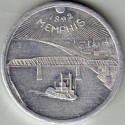 |
 |
 |
 |
|
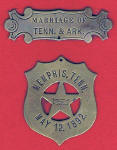 |
|
Souvenir Coin 1892 |
Souvenir Coin -back |
Souvenir 1892 |
1892 Article |
1892
Opening Day Memorabilia |
|
|
|
|
|
 |
 |
 |
 |
|
Drawing 1891 |
Harahan Bridge |
Memphis and Harahan Bridges |
Commercial Appeal Article
9-15-1977 |
|
|
|
|
|
|
|
|
|
|
|
|
|
|
|
 |
|
|
|
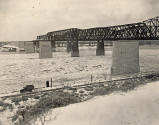 |
| 1948
Construction |
|
|
|
1948 ice on
River |
|
|
|
|
|
|
|
|
|
|
|
|
|
|
|
Credits |
|
|
|
|
|
The
Historic-Memphis website does not intentionally post copyrighted
photos and material without permission or credit.
On
occasion a "non-credited" photo might possibly be posted because we
were unable to find a name to give credit. Because of the nature of
our non-commercial, non-profit, educational website, we strongly
believe that these photos would be considered "Fair Use. We have
certainly made no monetary gain, although those using this website
for historic or Genealogy research have certainly profited. If by
chance,
we have posted your copyrighted photo, please contact us, and we'll
remove it immediately, or we'll add your credit if that's your
choice. In the past, we have found that many photographers
volunteer to have their works included on these pages and we'll
also do that if you contact us with a photo that fits a particular
page. |
|
|
|
|
|
|
|
The "Historic-Memphis" website would like to acknowledge and thank the
following for their contributions which helped make this website
possible: Google
Earth, Memphis
Public Library, Memphis University Library, Memphis Law Library,
Memphis Commercial Appeal, Memphis Press Scimitar, Shelby County
Register of Deeds, Memphis City Schools, Memphis Business Men's
Club, Memphis Chamber of Commerce, Memphis City Park Commission,
Memphis Film Commission, Carnival Memphis, Memphis Historical
Railroad Page, Memphis Heritage Inc, Beale Street Historic District,
Cobblestone Historic District, Memphis Historic Districts, Vance
Lauderdale Family Archives, Tennessee State Archives, Library of
Congress, Kemmons Wilson Family, Richard S. Brashier, Lee Askew,
George Whitworth, Woody Savage and many individuals whose assistance is
acknowledged on the pages of their contributions. Special
thanks to Memphis Realtor, Joe Spake, for giving us carte blanche
access to his outstanding collection of contemporary Memphis photos.
We do not have high definition copies of the photos on these
pages. If anyone wishes to secure high definition photos,
you'll have to contact the photographer or the collector.
(To avoid any possibility of contributing to SPAM, we do not
maintain a file of email addresses for anyone who contacts us). |
|
|
|
|
|
|
|
 |
|
|
|
|
|
|
|
|
|
|
|
|
|
|